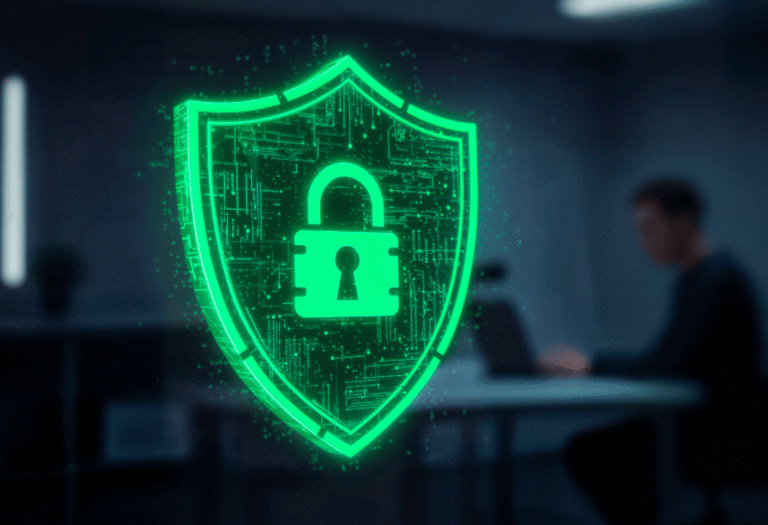Cybersecurity for Small Business: You Don’t Need to Be a Tech Expert
Lots of small business owners think cybersecurity is all about complicated tech stuff or pricey IT teams. That idea can leave their companies wide open to cyber threats that might halt operations or put customer data at risk.

You really don’t need to be a tech whiz to make a big difference in your small business cybersecurity and block common attacks. There’s plenty of evidence that straightforward steps can set up solid defenses, no fancy IT background required. (Cybersecurity fundamentals for non-IT business owners)
Small businesses deal with real cyber risks every day. 41% of small businesses reported experiencing a cyberattack in 2023.
The reality is, basic security practices can block most attacks if you know what to do and actually do it.
What You’ll Learn?
- Cybersecurity for small businesses is more about leadership and simple habits than technical know-how
- Stuff like strong passwords and basic employee training can stop most attacks
- Making security part of your company culture protects data and helps you stay compliant
Why Cybersecurity Matters for Small Businesses
Small businesses get hit hard by cyber threats that can wreck their operations and reputation. 43% of cyberattacks target small businesses.
Even worse, 60% of small businesses go under within six months of a cyberattack. That’s a scary stat.
The Real Risks for Small Businesses
Cybercriminals like going after small businesses because the security is usually weaker. Your business handles valuable customer data—credit card numbers, addresses, personal info—that’s exactly what they want.
Common cyber threats include:
- Ransomware attacks that lock you out of your files until you pay up
- Phishing emails designed to trick your team into handing over passwords
- Data breaches that leak customer info
- Malware that damages your systems or steals data
Customer data lives all over the place—payment systems, email, cloud databases. Each spot is a potential entry point for hackers.
Think you’re too small for anyone to care? Not really. Hackers use automated tools to scan thousands of businesses for weak spots, no matter the size.
Financial and Reputational Consequences
One breach can cost you thousands. There’s the direct stuff—fixing systems, legal bills, notifying customers.
But the hidden costs? Lost business while you’re down, and that can sting even more.
Financial impacts include:
- Average loss of $200,000 per incident for small businesses
- Revenue lost while you recover
- Legal fees, compliance fines
- Paying for credit monitoring for customers
Your reputation can unravel overnight. If customers’ info gets stolen, trust is gone. They’ll leave, and they’ll tell their friends, too.
Reputational damage includes:
- Loss of customer trust
- Bad reviews and negative social media
- Tougher time getting new customers
- Potential loss of business partnerships
Some businesses just can’t bounce back from a big cyber incident. The combo of losing money and trust can be fatal.
Misconceptions About Cyberattacks
There are a lot of myths floating around that keep small business owners from taking action. These misconceptions can leave you exposed.
Common misconceptions:
- “We’re too small to be targeted” – Actually, 99.9% of US businesses are small, so hackers see you as low-hanging fruit
- “We don’t have valuable data” – Names, addresses, payment info? Hackers want it all
- “Cybersecurity is too expensive” – Basic protections cost way less than cleaning up after an attack
Honestly, you don’t need to be a tech pro to protect your business. Simple things like strong passwords, software updates, and a bit of employee training go a long way.
Cybercriminals are going after small businesses more than ever. They know you probably don’t have a big security budget. But that doesn’t mean you’re safe.
Fundamentals of Small Business Cybersecurity Without Technical Jargon

Getting cybersecurity right starts with knowing what’s out there and what you actually need to protect. You don’t have to overthink it—just understand the basics, use a few layers of protection, and keep tabs on your digital stuff.
Understanding Common Cyber Threats
Phishing attacks are all about tricking your team into giving up passwords or clicking dangerous links. They usually come in emails that look legit.
Attackers might pretend to be your bank, a customer, or even a business partner. They’ll ask for login info or payment details. If your staff hasn’t been trained, these can be hard to spot.
Malware is nasty software that sneaks onto your computers. It can steal data, slow things down, or let hackers into your network.
Ransomware takes it up a notch—it locks your files and demands money to get them back. This can freeze your business until you pay or restore from backups.
Insider threats come from people who already have access—current or former employees. Sometimes it’s on purpose, sometimes just a dumb mistake.
Password attacks? Hackers try to guess or steal your logins. Weak passwords make their job way too easy.
Layered Security for Non-Tech Owners
Think about home security: locks, alarms, maybe a big dog. Cybersecurity works the same way—layers keep you safer.
First layer: Strong passwords and good login habits. Use different passwords everywhere. Turn on two-step logins when you can.
Second layer: Keep your software updated. Install updates as soon as they pop up. Old software is like leaving a window open.
Third layer: Train your employees. Show them what phishing looks like and set some clear ground rules about online behavior.
Fourth layer: Back up your stuff. Save copies of important files somewhere safe. Know how to get back up and running if something goes wrong.
You don’t need fancy tools to get started. Basic cybersecurity steps can block most threats, no IT degree required.
Identifying Your Digital Assets
Your digital assets are basically everything your business uses or stores electronically. Make a list—it’s boring, but worth it.
Business data means customer info, financials, employee files, and company docs. Hackers love this stuff, so keep it safe.
Jot down all your devices:
- Computers and laptops
- Phones and tablets
- Servers and storage
- Network gear
Don’t forget your online accounts:
- Banking and payments
- Customer databases
- Cloud storage
Figure out where your important files actually live. Some are on office computers, others in the cloud, maybe even on someone’s phone.
Rank your assets. What would hurt most if it vanished or got stolen? Start there with your protections.
Update your list whenever your business changes or grows. It’s easy to forget what’s new.
Essential Cybersecurity Practices Any Small Business Can Implement
Small businesses don’t need to get fancy to stay protected. Focus on four basics: strong passwords with a password manager, multi-factor authentication, keeping software updated with security patches, and using antivirus software and firewalls.
Strong Passwords and Password Managers
Passwords are your first defense. Weak ones? That’s like leaving your front door wide open for hackers.
Strong passwords should be at least 12 characters, with uppercase, lowercase, numbers, and symbols. Skip the obvious stuff—no birthdays or business names.
Don’t reuse passwords. If one gets hacked, the rest are sitting ducks.
A password manager makes life easier. It creates unique, tough passwords for every account and remembers them. You just need to keep track of one master password.
| Password Manager Benefits | How It Helps |
|---|---|
| Generates strong passwords | Builds long, complex passwords automatically |
| Stores passwords securely | Encrypts everything so hackers can’t read it |
| Fills passwords automatically | No more typing errors or forgotten logins |
| Works on all devices | Keeps passwords synced across your computer, phone, and tablet |
Some good options: Bitwarden, 1Password, Dashlane. Most business plans are under $5 a month. Not bad for peace of mind.
Set up your password manager as soon as you can. Start with your most important accounts—email, banking, cloud storage. You’ll thank yourself later.
Multi-Factor Authentication Basics
Multi-factor authentication (MFA) adds another step when you log in. Even if someone has your password, they can’t get in without the second factor.
MFA compliance is critical for business accounts. It stops most password-based attacks cold.
MFA usually means you need two things:
- Something you know (your password)
- Something you have (like your phone or a security key)
The most common approach sends a code to your phone by text. You enter the code after your password.
Some apps, like Google Authenticator, give you codes that change every 30 seconds. It’s a bit more work, but way safer.
Hardware security keys are even better. These little devices plug into your computer’s USB port. They use FIDO tech, which basically stops phishing in its tracks.
Turn on MFA for these accounts first:
- Business email accounts
- Cloud storage services
- Banking and financial accounts
- Social media business pages
- Website hosting accounts
Most services have MFA for free. Look for settings called “Two-Factor Authentication,” “Security,” or “Account Protection.”
Seriously, turn it on for every business account you can.
Updating Software and Security Patches
Software updates patch up security holes hackers love to exploit. If your software’s old, you’re a much easier target.
Security patches close those gaps before criminals can use them. Companies push out patches when new threats pop up.
Set up automatic updates when you can. Your operating system, web browser, and business software should all update on their own.
This usually happens in the background, so you won’t even notice.
For stuff that doesn’t update automatically, check for updates every week. This includes:
- Accounting software
- Customer management systems
- Website plugins and themes
- Mobile apps on business devices
Keep an eye on CISA’s Known Exploited Vulnerabilities catalog. If you see a problem that affects your software, fix it first.
Set a simple update schedule. Pick a day each week to check all your business devices. It only takes 10-15 minutes.
Don’t put off important security updates. Try to install them within a day or two of release.
The longer you wait, the bigger the risk.
Using Antivirus and Firewall Protection
Antivirus software catches and removes bad programs before they can mess up your business. Good antivirus also blocks shady websites and sketchy email attachments.
Go for business-grade antivirus, not the free stuff. Business versions protect more devices and have better management features.
Look for these features:
- Real-time scanning that checks files as you open them
- Email protection that blocks dangerous attachments
- Web filtering that stops malicious websites
- Automatic updates for new virus definitions
Firewalls decide what data can get in and out of your network. They block unauthorized access and weird network activity.
There are two kinds of firewall protection:
- Software firewalls protect individual computers
- Hardware firewalls protect your whole network at the router
Use both for solid protection. Your router’s firewall covers everything on your network. Computer firewalls add another layer.
Block unnecessary network ports with your firewall. Only open what your business actually needs.
Most small businesses don’t need many open ports anyway.
Check firewall logs once a month. Look for weird activity like repeated connection attempts from unknown places or blocked traffic.
Protecting Sensitive Business Information and Ensuring Compliance

Small businesses deal with three main types of sensitive data: customer personal info, financial records, and health information.
Good data protection means strong passwords, encryption, and employee training—plus following the law where it applies.
Protecting Customer and Business Data
Your business collects info that criminals really want. This means customer names, addresses, phone numbers, and payment details.
It also covers your own business records, like employee files and financial data.
Financial Information includes credit card numbers, bank accounts, and payment history.
Personal data covers names, addresses, social security numbers, and birth dates.
Health information means medical records and insurance details.
Set up different access levels for your data. Not everyone needs to see everything.
Give people access only to what they need for their job.
Use strong passwords—at least 12 characters, with numbers, symbols, and both upper and lower case letters.
Change default passwords right away on all devices and software.
Back up your data regularly. Store copies in different places.
Test your backups so you know they’ll actually work if you need them.
Recognizing and Avoiding Phishing Emails
Phishing emails try to trick people into giving up passwords or clicking dangerous links. Small businesses get targeted because their defenses aren’t always great.
Watch out for these red flags:
- Urgent language like “act now” or “immediate action required”
- Spelling and grammar mistakes
- Generic greetings like “Dear Customer”
- Requests for passwords or personal info
- Links that don’t match the sender’s website
Don’t click links or download files from sketchy emails. If you’re not sure, reach out to the sender another way to check if it’s real.
Train your team to spot scams. Run practice tests with fake phishing emails to see who needs more help.
Encryption and Secure Data Storage
Data encryption scrambles your info so only the right people can read it. It’s like a secret code that protects your data even if someone steals it.
Encrypt data on your computers and when it travels over the internet. Most modern devices have built-in encryption tools—just turn them on for laptops, phones, and tablets.
Use secure cloud storage that encrypts your files. Google Drive, Dropbox Business, and Microsoft OneDrive are solid picks. Make sure they meet your industry’s security standards.
Password-protect important files and folders. Use different passwords for different types of data.
Store your passwords in a password manager so you don’t lose track.
Navigating Regulatory Requirements
Every industry seems to have its own rules for keeping data safe. HIPAA governs health information for medical businesses.
PCI DSS applies to any business that takes credit card payments. If you’re handling cards, you’ve got to pay attention.
The GDPR affects businesses that serve customers in Europe. It’s all about protecting personal data and giving people more control over their info.
First, figure out which rules actually matter for your business. What kind of data do you collect? And where do your customers live?
If you’re unsure, it’s worth asking a lawyer who knows privacy law. Sometimes you just need an expert to clear things up.
Create written policies that lay out how you keep data secure. Make sure your employees know the drill.
Document your security steps, just in case someone comes asking. Regulators love paperwork, unfortunately.
Check your compliance regularly. Rules shift, and your business probably isn’t standing still either.
Frequently Asked Questions
1. Are small businesses really a target for hackers?
2. What’s the financial toll of a cyberattack on a small business?
3. What are the most frequent types of cyber threats for small businesses?
4. Can simple cybersecurity practices actually help?
5. What’s the business benefit of implementing cybersecurity measures?
6. What steps should small business owners prioritize first?

